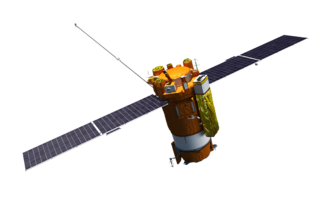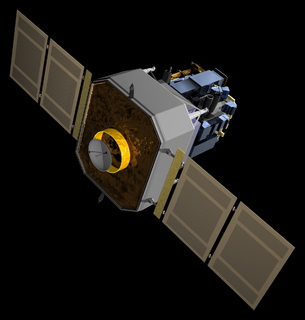 W
WAditya or Aditya-L1 is a spacecraft mission to study the Sun. It has been designed and will be built in collaboration between the Indian Space Research Organisation (ISRO) and various Indian research institutes. It is planned to be launched in January 2022. It is India's first solar mission.
 W
WAdvanced Composition Explorer (ACE) is a NASA Explorers program Solar and space exploration mission to study matter comprising energetic particles from the solar wind, the interplanetary medium, and other sources.
 W
WGenesis was a NASA sample-return probe that collected a sample of solar wind particles and returned them to Earth for analysis. It was the first NASA sample-return mission to return material since the Apollo program, and the first to return material from beyond the orbit of the Moon. Genesis was launched on August 8, 2001, and the sample return capsule crash-landed in Utah on September 8, 2004, after a design flaw prevented the deployment of its drogue parachute. The crash contaminated many of the sample collectors. Although most were damaged, some of the collectors were successfully recovered.
 W
WThe Geomagnetic Field Monitoring Program, is a scientific mission of the Space and Upper Atmosphere Research Commission of Pakistan (SUPARCO) to undertake research in geophysics, particularly geomagnetism. The objective of the mission is to provide better understanding of the Earth's magnetic field, and of associated hazard mitigation. The program monitors mathematical variation in the South Asian regional geomagnetic field. Research is conducted in specially established geomagnetic observatories in Islamabad and Karachi. Data collected provides the basis for continuous studies of Earth's magnetic field, and is made available to various national and international institutions.
 W
WHelios-A and Helios-B are a pair of probes that were launched into heliocentric orbit to study solar processes. As a joint venture of West Germany's space agency DLR and NASA the probes were launched from Cape Canaveral Air Force Station, Florida, on December 10, 1974, and January 15, 1976, respectively. As built by the main contractor, Messerschmitt-Bölkow-Blohm, they were the first space probes built outside the United States and the Soviet Union to leave Earth's orbit.
 W
WHinode, formerly Solar-B, is a Japan Aerospace Exploration Agency Solar mission with United States and United Kingdom collaboration. It is the follow-up to the Yohkoh (Solar-A) mission and it was launched on the final flight of the M-V rocket from Uchinoura Space Center, Japan on 22 September 2006 at 21:36 UTC. Initial orbit was perigee height 280 km, apogee height 686 km, inclination 98.3 degrees. Then the satellite maneuvered to the quasi-circular sun-synchronous orbit over the day/night terminator, which allows near-continuous observation of the Sun. On 28 October 2006, the probe's instruments captured their first images.
 W
WThe Interface Region Imaging Spectrograph (IRIS), also called Explorer 94, is a NASA solar observation satellite. The mission was funded through the Small Explorer program to investigate the physical conditions of the solar limb, particularly the chromosphere of the Sun. The spacecraft consists of a satellite bus and spectrometer built by the Lockheed Martin Solar and Astrophysics Laboratory (LMSAL), and a telescope provided by the Smithsonian Astrophysical Observatory. IRIS is operated by LMSAL and NASA's Ames Research Center.
 W
WKoronas-Foton, also known as CORONAS-Photon, was a Russian Solar research satellite. It is the third satellite in the Russian Coronas programme, and part of the international Living With a Star programme. It was launched on 30 January 2009, from Site 32/2 at the Plesetsk Cosmodrome, aboard the final flight of the Tsyklon-3 rocket. On 1 December 2009 all scientific instruments on the satellite were turned off due to the problems with power supply that were caused by a design flaw. On 18 April 2010 the creators of the satellite announced it was lost "with a good deal of certainty".
 W
WThe Parker Solar Probe is a NASA Space Probe launched in 2018 with the mission of making observations of the outer corona of the Sun. It will approach to within 9.86 solar radii from the center of the Sun, and by 2025 will travel, at closest approach, as fast as 690,000 km/h (430,000 mph), or 0.064% the speed of light.
 W
WPioneer 6, 7, 8, and 9 were space probes in the Pioneer program. They were a series of solar-orbiting, spin-stabilized, solar cell- and battery-powered satellites designed to obtain measurements on a continuing basis of interplanetary phenomena from widely separated points in space. They were also known as Pioneer A, B, C, and D. The fifth was lost in a launch accident, and therefore did not receive a numerical designation.
 W
WPioneer H is an unlaunched unmanned space mission that was part of the US Pioneer program for a planned 1974 launch. Had this mission and spacecraft been launched, it would have been designated Pioneer 12; that designation was later applied to the Pioneer Venus Orbiter.
 W
WReuven Ramaty High Energy Solar Spectroscopic Imager was a NASA solar flare observatory. It was the sixth mission in the Small Explorer program, selected in October 1997 and launched on 5 February 2002. Its primary mission was to explore the physics of particle acceleration and energy release in solar flares.
 W
WSOLAR was an ESA science observatory on the Columbus Laboratory, which is part of the International Space Station. SOLAR was launched with Columbus on February 2008 aboard STS-122. It was externally mounted to Columbus with the European Technology Exposure Facility (EuTEF). SOLAR has three main space science instruments: SOVIM, SOLSPEC and SOL-ACES. Together they provide detailed measurements of the Sun's spectral irradiance. The SOLAR platform and its instruments are controlled from the Belgian User Support and Operations Centre (B.USOC), located at the Belgian Institute for Space Aeronomy (BISA) in Uccle, Belgium.
 W
WThe Solar and Heliospheric Observatory (SOHO) is a spacecraft built by a European industrial consortium led by Matra Marconi Space that was launched on a Lockheed Martin Atlas II AS launch vehicle on December 2, 1995, to study the Sun. It has also discovered over 3,000 comets. It began normal operations in May 1996. It is a joint project between the European Space Agency (ESA) and NASA. Originally planned as a two-year mission, SOHO continues to operate after over 25 years in space; the mission has been extended until the end of 2020 with a likely extension until 2022.
 W
WThe Solar Dynamics Observatory (SDO) is a NASA mission which has been observing the Sun since 2010. Launched on February 11, 2010, the observatory is part of the Living With a Star (LWS) program.
 W
WThe Solar Orbiter (SolO) is a Sun-observing satellite, developed by the European Space Agency (ESA). SolO is intended to perform detailed measurements of the inner heliosphere and nascent solar wind, and perform close observations of the polar regions of the Sun, which is difficult to do from Earth, both serving to answer the question "How does the Sun create and control the heliosphere?"
 W
WSTEREO is a solar observation mission. Two nearly identical spacecraft were launched in 2006 into orbits around the Sun that cause them to respectively pull farther ahead of and fall gradually behind the Earth. This enables stereoscopic imaging of the Sun and solar phenomena, such as coronal mass ejections.
 W
WTransition Region and Coronal Explorer (TRACE) was a NASA heliophysics and solar observatory designed to investigate the connections between fine-scale magnetic fields and the associated plasma structures on the Sun by providing high resolution images and observation of the solar photosphere, the transition region, and the corona. A main focus of the TRACE instrument is the fine structure of coronal loops low in the solar atmosphere. TRACE is the fourth spacecraft in the Small Explorer program, launched on April 2, 1998, and obtained its last science image on 21 June 2010 23:56 UT.
 W
WThe Soviet space program was the national space program of the Union of Soviet Socialist Republics (USSR), active from the 1950s until the state's collapse in 1991.
 W
WTwo Wide-Angle Imaging Neutral-Atom Spectrometers (TWINS) are a pair of NASA instruments aboard two United States National Reconnaissance Office satellites in Molniya orbits. TWINS was designed to provide stereo images of the Earth's ring current. The first instrument, TWINS-1, was launched aboard USA-184 on 28 June 2006. TWINS-2 followed aboard USA-200 on March 13, 2008.
 W
WUlysses is a decommissioned robotic space probe whose primary mission was to orbit the Sun and study it at all latitudes. It was launched in 1990 and made three "fast latitude scans" of the Sun in 1994/1995, 2000/2001, and 2007/2008. In addition, the probe studied several comets. Ulysses was a joint venture of NASA and the European Space Agency (ESA) with participation from Canada's National Research Council. The last day for mission operations on Ulysses was June 30, 2009.